A Novel Flood Regional Composition Method for Design Flood Estimation in the Cascade Reservoirs
Abstract
1. Introduction
2. Methodology
2.1. Copula Function
2.2. Flood Regional Composition (FRC) Method
2.3. Equivalent-Frequency Flood Regional Composition (EFFRC) Method
- (1)
- If both design floods in the downstream section and upstream reservoir are equal in design frequency p, and their flood volumes are represented as zp and xp, then according to the principle of water balance, the flood volume y at inter-basin B is given by zp − xp. So, [xp, zp − xp] was one of the EFFRC schemes for a single reservoir system.
- (2)
- If design floods in the downstream section and interval basin B are equal in frequency, then similarly, the flood volume X at the upstream reservoir A site is given by x = zp − yp, and [zp − yp, yp] was the other EFFRC scheme for a single reservoir system.
2.4. Most Likely Flood Regional Composition (MLFRC) Method
2.5. Most Unfavorable Flood Regional Composition (MUFRC) Method
2.6. Design Flood Estimation in Cascade Reservoir Operation Period
3. Case Study
3.1. Cascade Reservoirs in the Yalong River Basin
3.2. The Marginal Distribution of Flood Data Series
3.3. The Joint Distribution of Flood Data Series
3.4. Design Flood Estimated by Three FRC Methods
- (1)
- The full utilization of flood control storage in upstream reservoirs has significantly changed the flood characteristic features at the downstream section. Compared with the originally designed values, the annual maximum peak discharge and maximum 1 d, 3 d, and 7 d flood volumes estimated by the MUFRC method at the TZL design section decreased by 36.6%, 36.1%, 33.0%, and 28.7%, respectively.
- (2)
- Traditionally, flood control standards define the highest water level for flood control during reservoir operation using a design flood hydrograph, which starts from the flood limit water level. Since the downstream flood control pressure has been lessened by the regulation of upper cascade reservoirs, the originally designed flood limit water level might fail to adapt to these alterations and could be redesigned for more benefits. Through reservoir operation and flood routing calculation, the flood control water levels of downstream controlled reservoirs like JP1 and ET could be appropriately derived with the flood prevention standard unchanged. Compared with the originally designed flood limit water level, the flood control water levels were increased by 3.39 m and 2.59 m, respectively.
- (3)
- The rise in flood control water level would correspondingly increase the net head of hydropower generator units. The redesigned water level could increase the total of hydropower generation (HG) in the Yalong River basin from 45.58 to 46.22 billion kW·h (+1.82%) during the flood season, indicating a significant increase in economic benefits.
4. Discussion and Comparison
4.1. Influence of Flood Disaster Loss
4.2. Sensitivity Analysis
4.3. Theoretical Derivation
5. Conclusions
- (1)
- The proposed MUFRC method would allocate more flood volume to the downstream uncontrolled sub-basin, and the precise definition of flood disaster loss could have a significant impact on the MUFRC method for the rational estimation of design flood.
- (2)
- The most unfavorable design flood of the Yalong River basin in the cascade reservoir operation period could be derived by MUFRC, and its peak discharge and maximum 1 d, 3 d, and 7 d flood volumes decreased by 36.6%, 36.1%, 33.0%, and 28.7%, respectively, compared with the originally designed values in the reservoir construction period.
- (3)
- The decrease in design flood would lessen the downstream flood control pressure. Hence, redesigned flood control water levels of JP1 and ET reservoirs could be raised to 1862.39 m and 1192.59 m, respectively, under the condition of the original flood prevention standards remaining unchanged. The rise in water level could generate 640 million kW·h (+1.82%) more hydropower during the flood season annually.
Author Contributions
Funding
Data Availability Statement
Acknowledgments
Conflicts of Interest
References
- Duan, W.; Guo, S.; Wang, J.; Liu, D. Impact of cascaded reservoirs group on flow regime in the middle and lower reaches of the Yangtze River. Water 2016, 8, 218. [Google Scholar] [CrossRef]
- Volpi, E.; Lazzaro, D.M.; Bertola, M.; Viglione, A.; Fiori, A. Reservoir effects on flood peak discharge at the catchment scale. Water Resour. Res. 2018, 54, 9623–9636. [Google Scholar] [CrossRef]
- MWR (Ministry of Water Resources). Regulation for Calculating Design Flood of Water Resources and Hydropower Projects; Water Resources and Hydropower Press: Beijing, China, 2006. (In Chinese)
- Guo, S.; Rizwan, M.; Liu, Z.; Xiong, F.; Yin, J. Design flood estimation methods for cascade reservoirs based on copulas. Water 2018, 10, 560. [Google Scholar] [CrossRef]
- Qi, W.; Liu, J. A non-stationary cost-benefit based bivariate extreme flood estimation approach. J. Hydrol. 2018, 557, 589–599. [Google Scholar] [CrossRef]
- Qi, W. A non-stationary cost-benefit analysis approach for extreme flood estimation to explore the nexus of risk, cost and non-stationarity. J. Hydrol. 2017, 554, 128–136. [Google Scholar] [CrossRef]
- Liu, P.; Lin, K.; Wei, X. A two-stage method of quantitative flood risk analysis for reservoir real-time operation using ensemble-based hydrologic forecasts. Stoch. Environ. Res. Risk Assess. 2015, 29, 803–813. [Google Scholar] [CrossRef]
- Zhang, X.; Liu, P.; Xu, C.; Gong, Y.; Cheng, L.; He, S. Real-time reservoir flood control operation for cascade reservoirs using a two-stage flood risk analysis method. J. Hydrol. 2019, 577, 123954. [Google Scholar] [CrossRef]
- Xie, Y.; Guo, S.; Xiong, L.; Tian, J.; Xiong, F. Nonstationary design flood estimation in response to climate change, population growth and cascade reservoir regulation. Water 2021, 13, 2687. [Google Scholar] [CrossRef]
- Xiong, F.; Guo, S.; Liu, P.; Xu, C.-Y.; Zhong, Y.; Yin, J.; He, S. A general framework of design flood estimation for cascade reservoirs in operation period. J. Hydrol. 2019, 577, 124003. [Google Scholar] [CrossRef]
- Xiong, F.; Guo, S.; Yin, J.; Tian, J.; Rizwan, M. Comparative study of flood regional composition methods for design flood estimation in cascade reservoir system. J. Hydrol. 2020, 590, 125530. [Google Scholar] [CrossRef]
- Jiang, C.; Xiong, L.; Xu, C.; Yan, L. A river network-based hierarchical model for deriving flood frequency distributions and its application to the upper Yangtze basin. Water Resour. Res. 2021, 57, e2020WR029374. [Google Scholar] [CrossRef]
- Rigby, A.; Stasinopoulos, M. Generalized additive models for location, scale and shape. J. R. Stat. Soc. Ser. C Appl. Stat. 2005, 54, 507–554. [Google Scholar] [CrossRef]
- López, J.; Francés, F. Non-stationary flood frequency analysis in continental Spanish rivers, using climate and reservoir indices as external covariates. Hydrol. Earth Syst. Sci. 2013, 17, 3189–3203. [Google Scholar] [CrossRef]
- Su, C.; Chen, X. Assessing the effects of reservoirs on extreme flows using nonstationary flood frequency models with the modified reservoir index as a covariate. Adv. Water Resour. 2018, 124, 29–40. [Google Scholar] [CrossRef]
- Wang, W.; Li, H.-Y.; Leung, L.R.; Yigzaw, W.; Zhao, J.; Lu, H.; Deng, Z.; Demisie, Y.; Blöschl, G. Nonlinear filtering effects of reservoirs on flood frequency curves at the regional scale. Water Resour. Res. 2017, 53, 8277–8292. [Google Scholar] [CrossRef]
- Lee, D.; Ward, P.J.; Block, P. Attribution of large-scale climate patterns to seasonal peak-flow and prospects for prediction globally. Water Resour. Res. 2018, 54, 916–938. [Google Scholar] [CrossRef]
- Yin, J.; Guo, S.; Liu, Z.; Yang, G.; Zhong, Y.; Liu, D. Uncertainty analysis of bivariate design flood estimation and its impacts on reservoir routing. Water Resour. Manag. 2018, 32, 1795–1809. [Google Scholar] [CrossRef]
- Zhang, X.; Liu, P.; Chen, J.; Xu, J.; Wang, Y.; Yao, L.; Hong, X. Research on the synergistic effect of multi-reservoir flood control capacity by considering the conditional value-at-risk. Adv. Water Sci. 2022, 33, 298–305. (In Chinese) [Google Scholar]
- Zhao, L.; Li, J.; Zhang, T.; Feng, P.; Wang, X.; Shen, J. Multi-method combined analysis of urban flood risks and its influencing factors under low impact development. J. Hydrol. 2024, 632, 130927. [Google Scholar] [CrossRef]
- Nelsen, R. An Introduction to Copulas, 2nd ed.; Springer: New York, NY, USA, 2006. [Google Scholar]
- Salvadori, G.; Durante, F.; Michele, C.; Bernardi, M.; Petrella, L. A multivariate copula-based framework for dealing with hazard scenarios and failure probabilities. Water Resour. Res. 2016, 52, 3701–3721. [Google Scholar] [CrossRef]
- Salvadori, G.; Michele, C. Frequency analysis via copulas: Theoretical aspects and applications to hydrological events. Water Resour. Res. 2004, 40, 12511. [Google Scholar] [CrossRef]
- UNDHA (United Nations Department of Humanitarian Affairs). Internationally Agreed Glossary of Basic Terms Related to Disaster Management; United Nations Department of Humanitarian Affairs: Geneva, Switzerland, 1992. [Google Scholar]
- Sun, Z.; Zhu, X.; Pan, Y.; Liu, X.F. Flood risk analysis: Progress, challenges and prospect. J. Catastrophology 2017, 32, 125–130+136. (In Chinese) [Google Scholar]
- Gopalan, P.S.; Kawamura, A.; Amaguchi, H.; Takasaki, T.; Azhikodan, G. A bootstrap approach for the parameter uncertainty of an urban-specific rainfall-runoff model. J. Hydrol. 2019, 579, 124195. [Google Scholar] [CrossRef]
- Bomers, A.; Schielen, J.M.R.; Hulscher, H.M.J.S. Decreasing uncertainty in flood frequency analyses by including historic flood events in an efficient bootstrap approach. Nat. Hazards Earth Syst. Sci. 2019, 19, 1895–1908. [Google Scholar] [CrossRef]
- Arnaud, P.; Cantet, P.; Odry, J. Uncertainties of flood frequency estimation approaches based on continuous simulation using data resampling. J. Hydrol. 2017, 554, 360–369. [Google Scholar] [CrossRef]



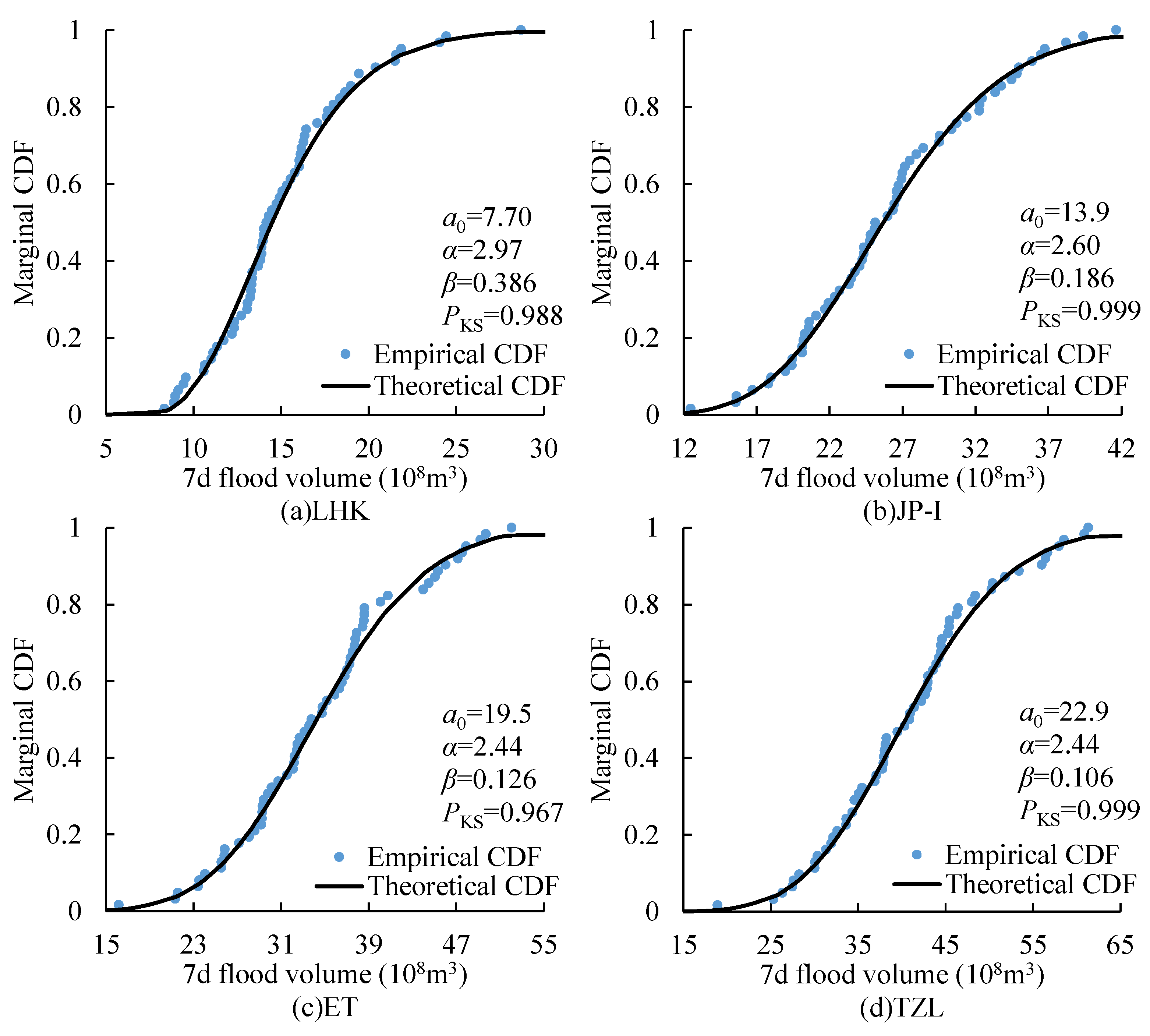

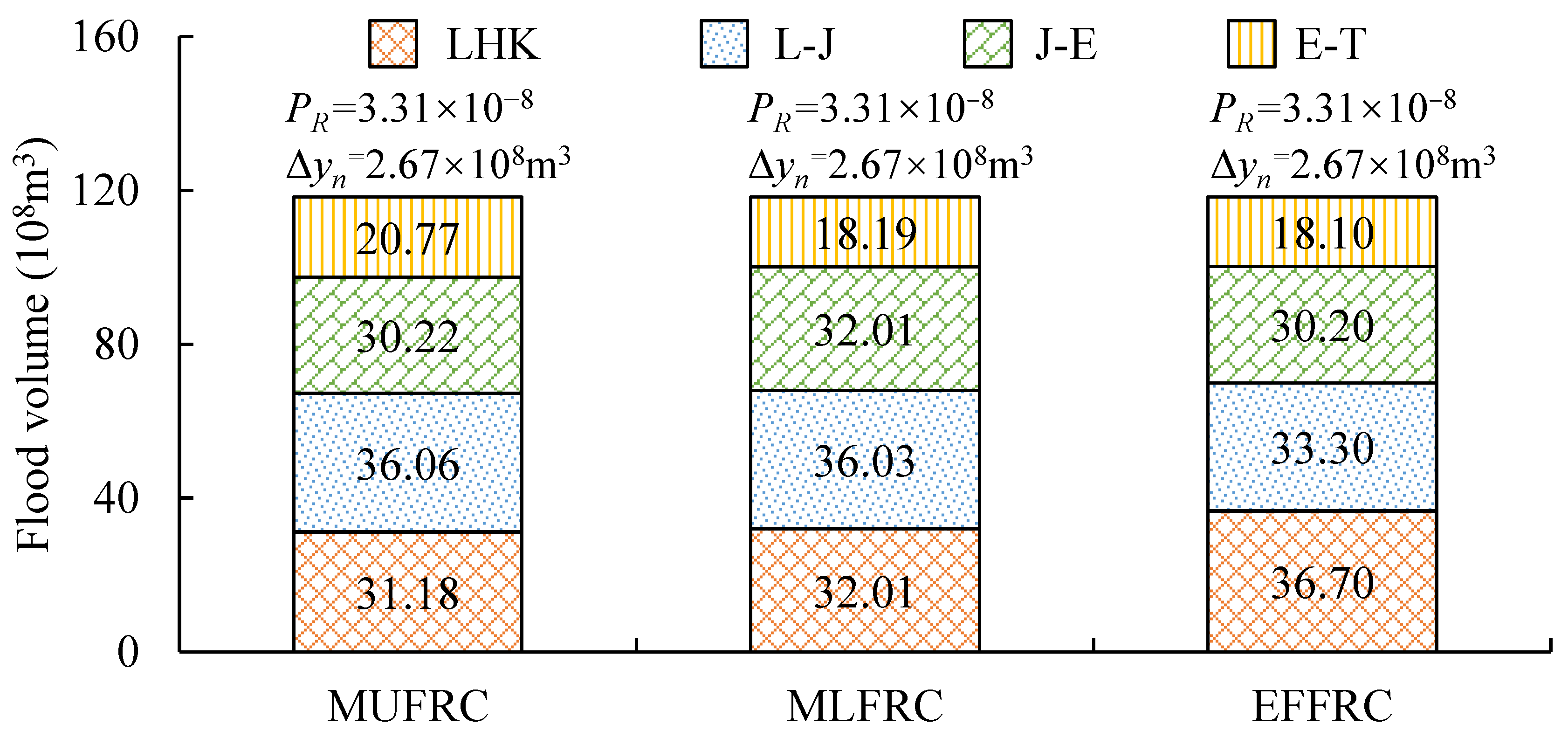
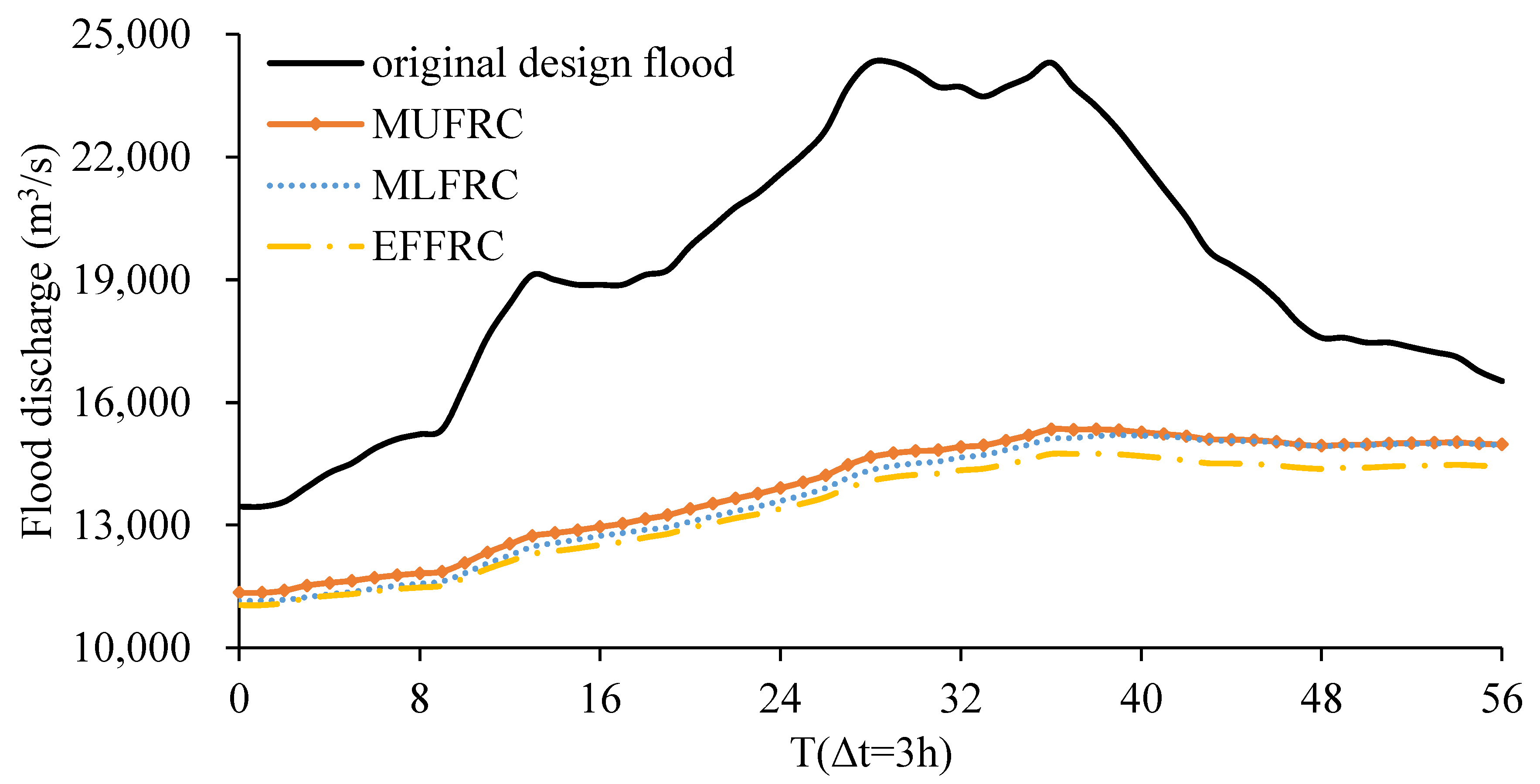
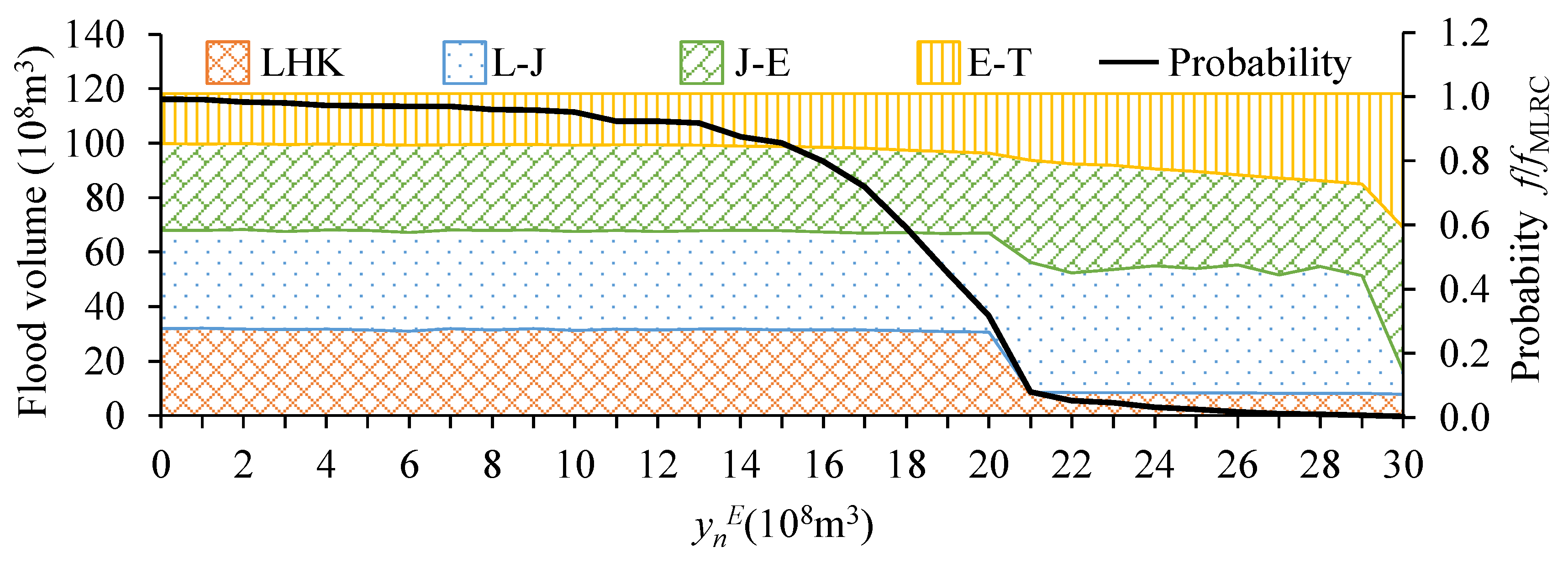
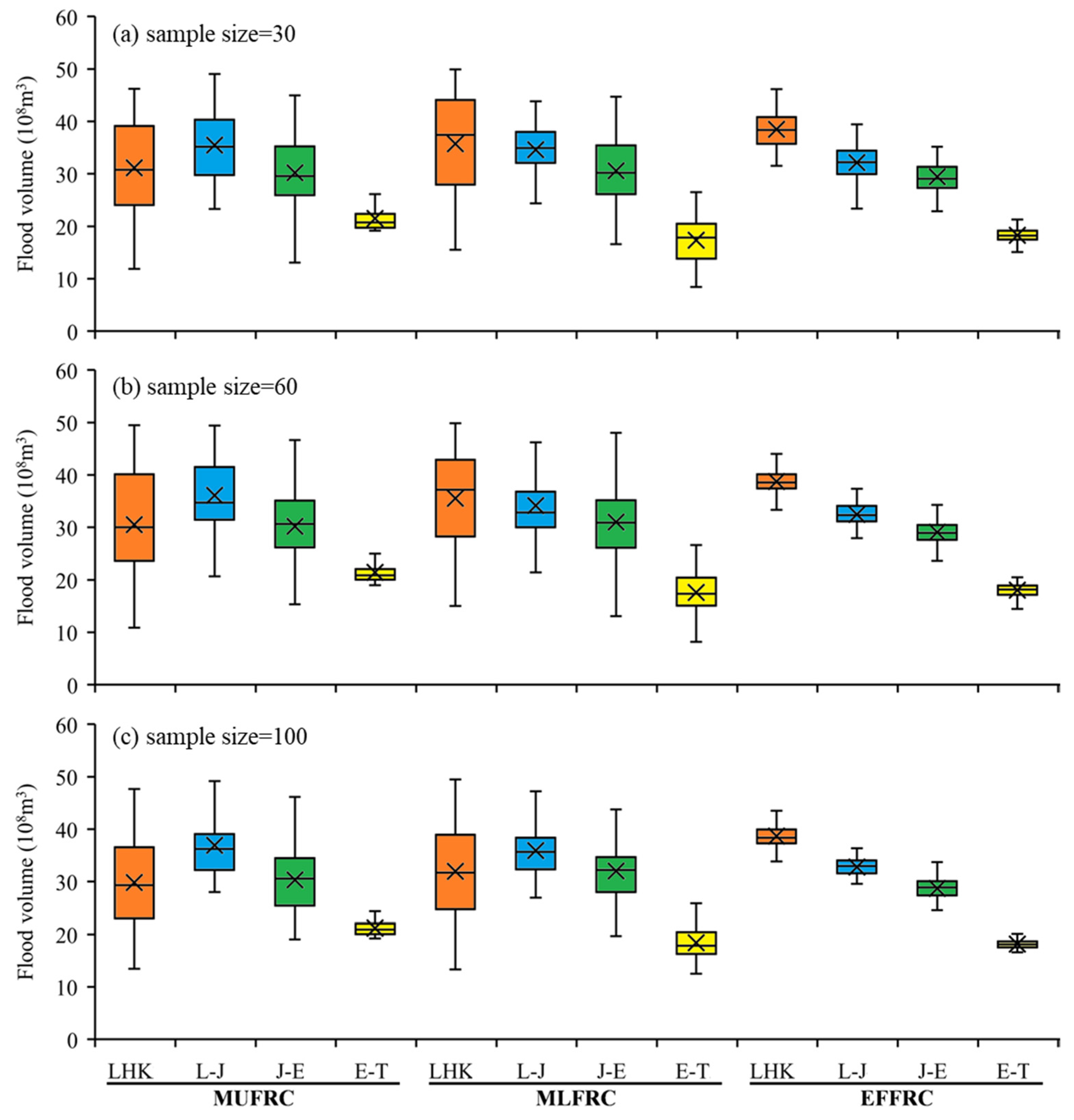
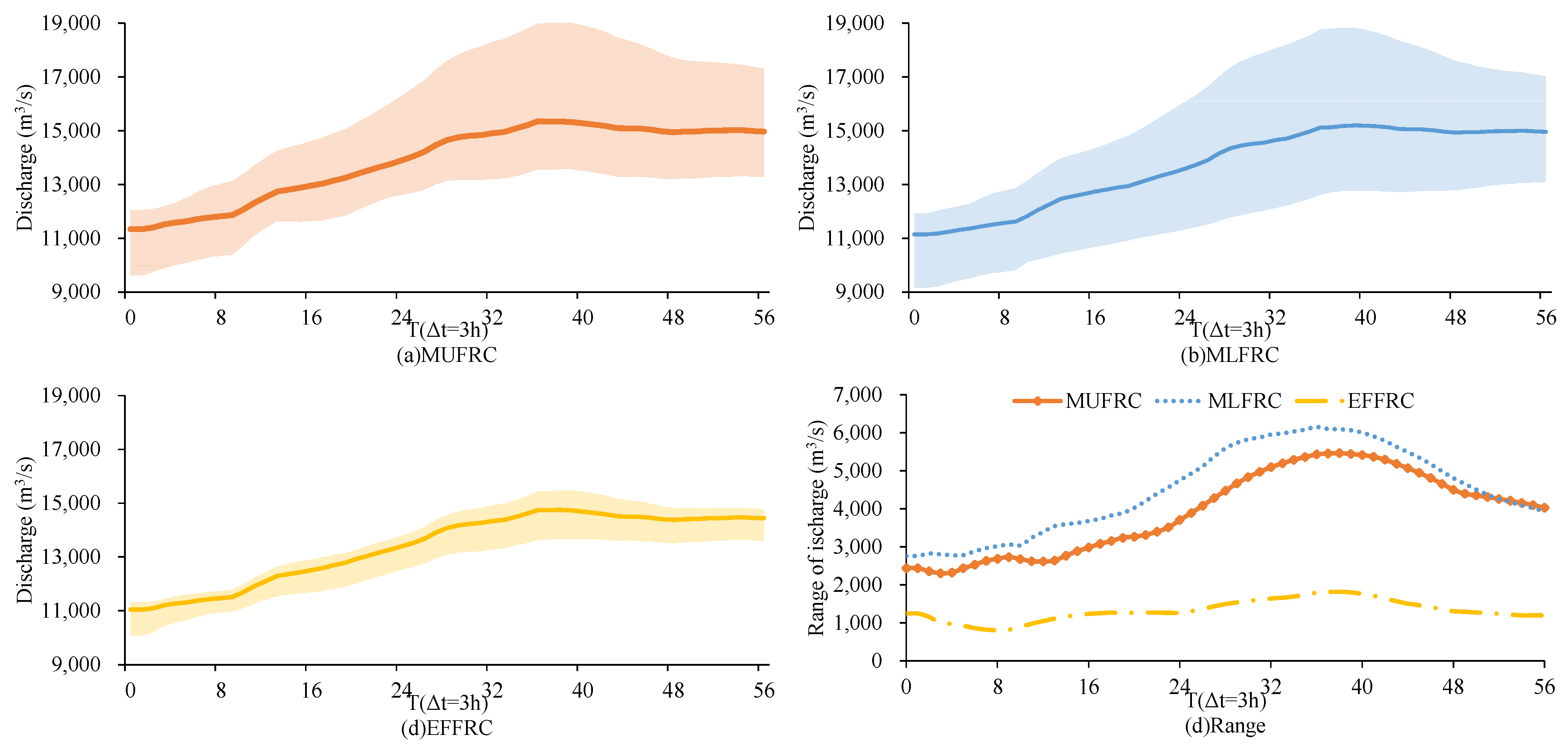
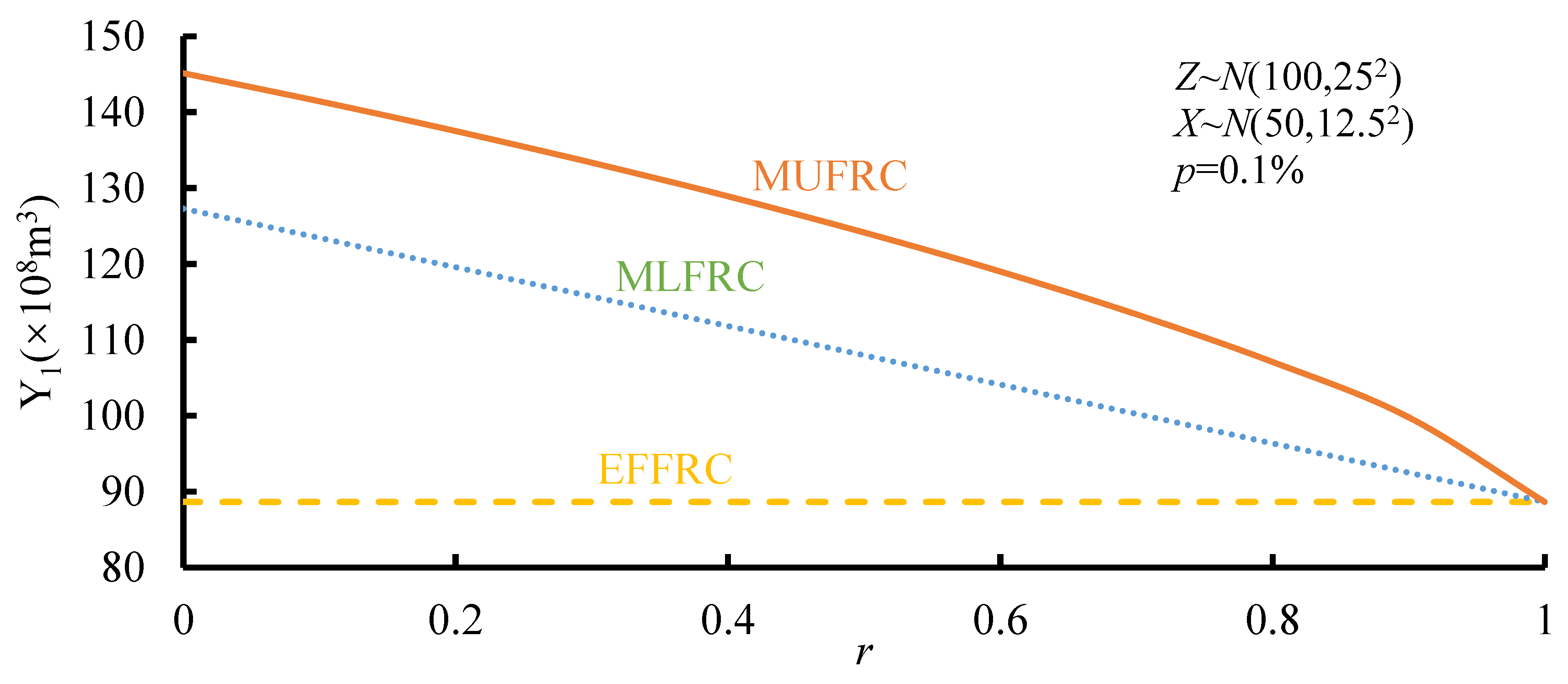
| Reservoir | LHK | YFG | JP1 | JP2 | GD | ET | TZL |
|---|---|---|---|---|---|---|---|
| Drainage area (thousand km2) | 65.72 | 80.88 | 102.56 | 102.66 | 110.12 | 116.49 | 127.67 |
| Normal pool level (m) | 2865 | 2094 | 1880 | 1646 | 1330 | 1200 | 1015 |
| Flood limit water level (m) | 2845.9 | - | 1859.0 | - | - | 1190.0 | - |
| Design flood water level (m) | 2867 | - | 1880.5 | - | - | 1200 | 1015 |
| Total storage capacity (billion m3) | 107.67 | 5.13 | 7.99 | 0.19 | 7.60 | 5.80 | 0.09 |
| Flood control storage (billion m3) | 2.00 | - | 1.60 | - | - | 0.90 | - |
| Installed hydropower capacity (GW) | 3.00 | 1.50 | 3.60 | 4.80 | 2.40 | 3.30 | 0.60 |
| Regulation capacity | multi-year | daily | annual | daily | daily | seasonal | daily |
| Gumbel Copula | Frank Copula | Clayton Copula | T-Copula | Vine Copula | |
|---|---|---|---|---|---|
| AIC | −164 | −168 | −155 | −307 | −330 |
| RMSE | 0.0355 | 0.0335 | 0.0612 | 0.0257 | 0.0227 |
| PKS | 0.81 | 0.92 | 0.81 | 0.99 | 0.93 |
| Design Flood (Unit) | Original Design | MUFRC | MLFRC | EFFRC |
|---|---|---|---|---|
| Peak discharge (Qmax) m3/s | 24,300 | 15,400 (−36.6%) | 15,200 (−37.5%) | 14,800 (−39.3%) |
| 1 d flood volume (W1) 108 m3 | 20.66 | 13.20 (−36.1%) | 13.20 (−36.6%) | 12.69 (−38.7%) |
| 3 d flood volume (W3) 108 m3 | 58.39 | 39.14 (−33.0%) | 38.93 (−33.3%) | 37.65 (−35.5%) |
| 7 d flood volume (W7) 108 m3 | 118.23 | 84.22 (−28.7%) | 83.06 (−29.7%) | 81.20 (−31.3%) |
Disclaimer/Publisher’s Note: The statements, opinions and data contained in all publications are solely those of the individual author(s) and contributor(s) and not of MDPI and/or the editor(s). MDPI and/or the editor(s) disclaim responsibility for any injury to people or property resulting from any ideas, methods, instructions or products referred to in the content. |
© 2024 by the authors. Licensee MDPI, Basel, Switzerland. This article is an open access article distributed under the terms and conditions of the Creative Commons Attribution (CC BY) license (https://creativecommons.org/licenses/by/4.0/).
Share and Cite
Zhong, S.; Guo, S.; He, Y.; Xie, Y. A Novel Flood Regional Composition Method for Design Flood Estimation in the Cascade Reservoirs. Water 2024, 16, 2190. https://doi.org/10.3390/w16152190
Zhong S, Guo S, He Y, Xie Y. A Novel Flood Regional Composition Method for Design Flood Estimation in the Cascade Reservoirs. Water. 2024; 16(15):2190. https://doi.org/10.3390/w16152190
Chicago/Turabian StyleZhong, Sirui, Shenglian Guo, Yanfeng He, and Yuzuo Xie. 2024. "A Novel Flood Regional Composition Method for Design Flood Estimation in the Cascade Reservoirs" Water 16, no. 15: 2190. https://doi.org/10.3390/w16152190
APA StyleZhong, S., Guo, S., He, Y., & Xie, Y. (2024). A Novel Flood Regional Composition Method for Design Flood Estimation in the Cascade Reservoirs. Water, 16(15), 2190. https://doi.org/10.3390/w16152190









